#prad564
Explore tagged Tumblr posts
Text
Thomas Cooked - the collapse of the oldest company in travel and their continued communication failures
By Matt Forner
SUMMARY: In the early morning hours of Monday, September 23, Thomas Cook Group PLC, formally announced bankruptcy and their entering into compulsory liquidation under U.K. law after failing to secure a £200 million loan from its bankers and the partially government-owned/taxpayer-controlled Royal Bank of Scotland (RBS). The world’s oldest travel company, which began in 1841, was closing its doors after 178 years. Sadly, the company known as one of Europe’s top no-hassle travel companies left 600,000 stranded passengers across the globe.

The United Kingdom, the largest Thomas Cook market, had 155,000 passengers stranded, triggering the largest peacetime repatriation effort in U.K. history. The Civil Aviation Authority (CAA), the United Kingdom’s equivalent to the Federal Aviation Administration (FAA), launched Operation Matterhorn to return all stranded passengers carrying a British passport. In total, the U.K. government paid for 150 aircraft from 50 partners which flew 746 individual flights at the cost of £600 million. The collapse also left 21,000 employees without work, many finding out of their job loss while still operating aircraft and flying 35,000 feet in the air. This horrendous situation must cause us to ask, what happened, and how did Thomas Cook’s failure to communicate successfully impact this disaster?
To understand the true scope of the Thomas Cook fiasco, it’s important to first understand who they were as a company and the massive scale at which they operated. At their collapse, Thomas Cook was known throughout Europe as one of the top low-cost, leisure-specific travel companies operating tours in Africa, Asia, Europe, North America, South America, the Middle East. Along with operating tours, Thomas Cook owned 550 brick-and-mortar travel agencies, 380 hotels and resorts, 17 ocean liners and cruise ships, and 151 aircraft flying to 82 destinations on almost every continent. They truly were a behemoth in the travel sector with their airline and travel stores being the crown jewels.

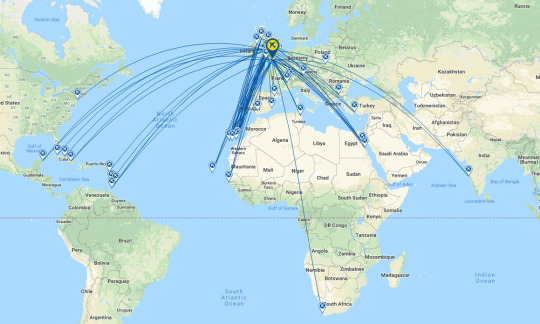
Despite their massive brand awareness, popularized in Europe by the advertising slogan, “Don’t just book it, Thomas Cook it,” as synonymous with their brand as their name, Thomas Cook failed to make the jump into the digital age throughout the 2000s.

In direct competition with Thomas Cook was a flooded air market comprised of easyJet, RyanAir, Norwegian, Vueling, WIZZ, Eurowings, Thomas Cook sister-company, Condor, and German leisure-specific airline and travel group, TUI. All carried lower overhead, focusing on one or two travel and hospitality segments, compared to Thomas Cook who had high fixed costs. The increasing usage of the internet offered more targeted travel experiences and companies including Kayak, Expedia, Priceline, Travelocity, Orbitz, TripAdivsor, Hostelworld, and Airbnb began to chip away at Thomas Cook’s travel store business, many times offering cheaper deals through multiple airline carriers and hospitality groups and undercutting Thomas Cook by not needing in-store travel agents. Partnerships between online travel booking companies and low-cost carriers also increased, many times leaving all of the Thomas Cook ventures out of the equation.

As travelers gained a plethora of options when it came to booking inexpensive flights, guided tours, and accommodations, the demand for a traditional all-inclusive, package style, physical travel agency, and tour company had changed. Furthermore, changes in travel attitudes and apprehension surrounding Brexit led to the gaining of popularity of staycations and less-expensive regional, European-based travel. For many Europeans, particularly Britons, travel has become cheaper, more frequent, less extravagant, and shorter in duration. Younger travelers are able to book inexpensive last-minute flights and hostel accommodations in a matter of minutes and older travelers can book a condo and private tours inexpensively halfway around the world. All these factors lead to less interest in an all-inclusive, long-duration, tour-based travel company like Thomas Cook.
Throughout the days and hours leading up to the collapse, all seemed normal. Thomas Cook flights were taking off and landing, tours were commencing, flights could still be booked on their website, and customer service employees were responding to passengers on Twitter. Thomas Cook sent their final tweet on September 22 at 9:40 p.m., reassuring a passenger that their travel plans would not be affected.
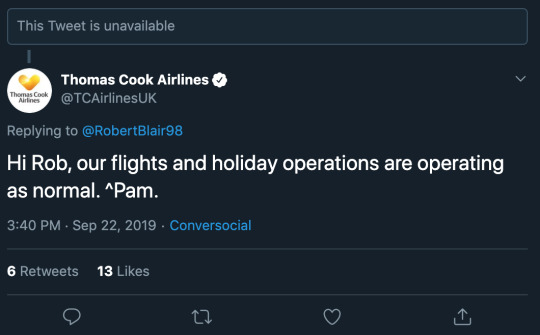
Without the public’s knowledge, an emergency overnight meeting between executives and creditors was taking place to look for any possible path forward. The airline had only roughly $200 million in liquid cash assets on hand and without an immediate cash infusion via a new loan, the 178-year-old company would shutter. Nobody outside the meeting knows exactly what was said in the room or what stalled negotiations, but it decided, that Thomas Cook was no longer able to operate and at 3:01 a.m., the Civil Aviation Authority took over Thomas Cook’s twitter and released the official statement of insolvency.

All around the world, at their very moment of insolvency, flights were boarding, planes were fueling, crews were preparing for takeoff, and passengers were ready to leave for vacation or head home. But at that moment, the company was gone. Everything had to stop. Pilots and flight crews were no longer employees, the fuel that just entered the plane would not be paid for, and planes were no longer owned or leased by the airlines. Travelers now faced a harsh reality. Their flight was canceled indefinitely and there wasn’t an airline to call to re-book. The Civil Aviation Authority (CAA) was now tasked with bringing home nearly 155,000 British travelers in the largest peacetime repatriation effort in U.K. history, codenamed Operation Matterhorn.
REACTION & PR Case Analysis: It’s clear on multiple levels where Thomas Cook messed up and directly walked into a major public relations, corporate communications, and brand reputational crisis. First off, Thomas Cook violated multiple Page principles, particularly numbers 3, 4, 5, and 7. As you will see, the cascading effect of violating multiple principles only further deepened the communications crisis.
3) Listen to stakeholders – Thomas Cook did not listen to stakeholders, both inside and outside the organization as they were heading toward an ultimate collapse. Numerous times multiple groups voiced concerns surrounding changing attitudes in travel with Thomas Cook reacting far too slowly to the high maneuverability of the digital age. This culminated in 2011 with a near-collapse in the business as stocks plummeted 75.2 percent as reports details Thomas Cook was seeking a £100m loan to prop up failing aspects of the business.
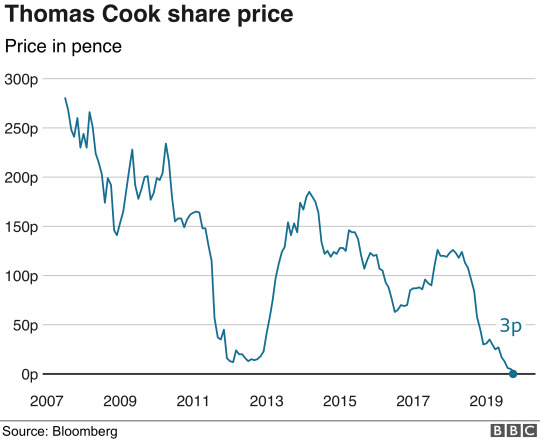
Following this event, stakeholders inside and outside the organization demanded a split in the company, separating the more profitable airline from portions of the business that were experiencing slowdowns, such as the hospitality and package tour operations. Thomas Cook leadership responded by slashing the number of travel stores from over 3,000 to just 550 and selling off expensive portions of the business. However, further calls from stakeholders to bring the business fully into the digital age were repeatedly rejected by Thomas Cook leadership and instead, a full re-branding campaign was executed in 2013.
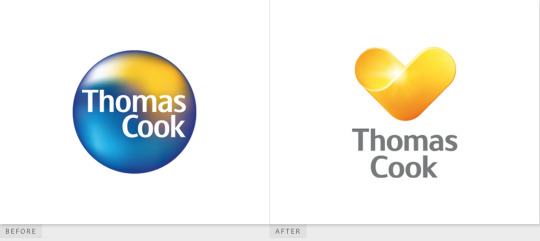
4) Manage for tomorrow – Thomas Cook failed to manage for tomorrow by continuously ignoring call after call to reorganize the company from stakeholders. Investors, financiers, members of the pilots union, and non-union staff across the organization called for a response to the changing travel and tourism industry. Furthermore, in the final days and hours of the business, when Thomas Cook leadership knew the business was certainly doomed, no effort was taken to help soon-to-be stranded passengers or provide an easy transition for employees. Twitter handle, @ThomasCookCares was taken down as it became clear the company cease to exist, offering stranded passengers and crew no way to contact the airline.

5) Conduct public relations as if the whole enterprise depends on it – Clearly, this was not Thomas Cook’s objective. During the final days of Thomas Cook’s operation, when it was clear to executives that their company was collapsing, leadership waited and failed to take accountability for the oncoming disaster. Not only did they not notify employees, passengers, or other key stakeholders, they failed to operate their business with a public relations mindset. To them, it was easier to delay the inevitable until the final moment when they could shut their doors and walk away without having to deal with the fallout. Of course, that fallout left 600,000 passengers and 21,000 employees stranded and out of work.
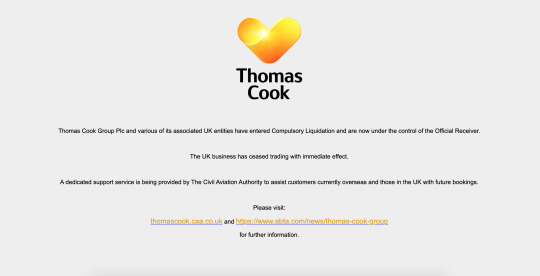
7) Remain calm, patient and good-humored – Thomas Cook failed at this principle by walking away from the disaster and not even attempting to fix their mistakes. Instead, the government and Thomas Cook’s competitors had to step in to fix the mess Thomas Cook created. Multiple airlines, including major competitors such as British Airways, Virgin Atlantic, and easyJet offered reduced fares for passengers needing repatriation, as well as stating they would create a special hiring division to bring Thomas Cook employees jobs. This lack of an effort on Thomas Cook’s part to remain calm, handle the situation as professionally as possible, and focus on.
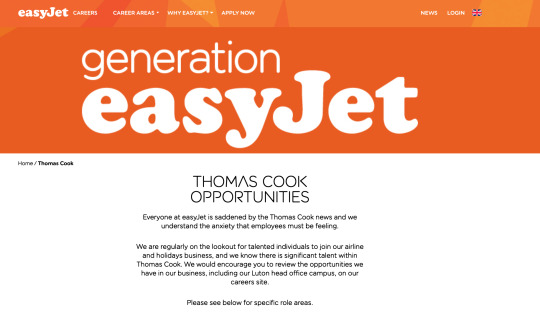
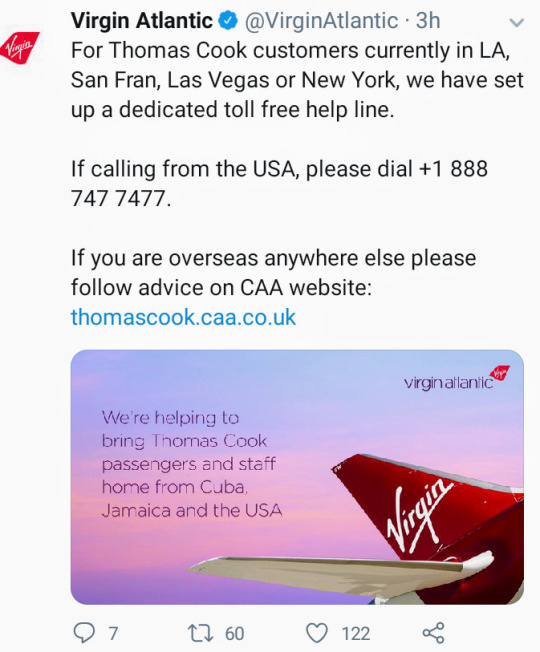
Sources:
- Cummins, Nicholas. 2019. "What Went Wrong For Thomas Cook?" Simple Flying, September 23. - Denise Roland, P.R. Venkat. 2019. "Thomas Cook Shuts Down, Forcing Britain to Fly Thousands Home." The Wall Street Journal, September 23. - Gill, Oliver. 2019. "Thomas Cook and RBS play blame game amid struggle for survival ." The Telegraph, September 20. - Hayden-Lefebvre, Thomas Jérémie. 2019. "The Impact of Thomas Cook’s Collapse on Tourism." Simple Flying, September 27. - James Hookway, Denise Roland. 2019. "First Dunkirk. Now, the Collapse of Thomas Cook." The Wall Street Journal, September 23. - Perez, Irene Garcia, and Luca Casiraghi. 2019. "Thomas Cook’s Liquidation Step by Step And What Happens Next." Bloomberg, September 23. - PRESS, ASSOCIATED. 2019. "Tour company Thomas Cook collapses, stranding hundreds of thousands of travelers ." The Los Angeles Times, September 23. - Shane Hickey, Helena Smith. 2019. "Thomas Cook staff and European tourist trade left reeling after collapse." The Guardian, September 29. - Sims, Shannon. 2019. "How Could Travel Giant Thomas Cook Fail?" The New York Times, September 23. - Sindreu, Jon. 2019. "What Thomas Cook’s Collapse Says About Modern Tourism ." The Wall Street Journal, September 23. - Wembridge, Mark, and Roger Blitz. 2011. "Thomas Cook plunges on debt concerns." Financial Times, November 22. - 2019. Why So Many Airlines are Going Bankrupt. Directed by Sam Denby Wendover Productions.
#travel#tourism#thomascook#communication#internal communication#corporate communication#public relations#prad564#airlines
0 notes
Text
Wayfair Missteps in Employee Walkout
By Joshua Smyser-DeLeon
Summary of the Wayfair Walkout
Wayfair is a Boston-based e-commerce website that sells furniture and other home decor. They use a drop ship model to get their products into the hands of customers. A drop ship model is when a retailer buys a product, ordered by a customer, from its suppliers and has that product shipped to the customer that placed the order. For example, when you buy a lamp from Wayfair, Wayfair will buy that lamp from a supplier and have it shipped to you for the price you agreed to pay via their website. This means they never physically have the products they sell. With this model, Wayfair is able to sell over 14 million items. It has 11,000 suppliers as well as five additional websites Joss & Main, AllModern, Perigold, and Birch Lane. In 2018 alone, it made $1.5 billion in gross profit (Wischhover, 2019).
youtube
In mid-June 2019, Wayfair employees discovered that the Baptist Child and Family Services (BCFS), a detention center operator, placed a $200,000 bedroom furniture order. This bedroom furniture was for a migrant detention center housing children in Carrizo Springs, Texas (Bhattarai, 2019). In reaction, on June 21st around 540 Wayfair employees signed and sent a letter to executives challenging the ethics of the current and future B2B sales (Mabud, 2019). Executives responded with their own internal letter acknowledging the concerns of their employees, but that the order would still be fulfilled. In response, over 500 employees staged a “Wayfair Walkout” to protest the company’s business conduct on June 26th.

A Twitter account, @wayfairwalkout, was also created and the following demands were tweeted on the day of the walkout.
commitment to requests made in employee letter
donate profits of sales from BCFS and similar contractors to the Refugee and Immigrant Center for Education and Legal Services (RAICES)
stop doing business with BCFS and similar contractors
create a code of ethics for B2B sales
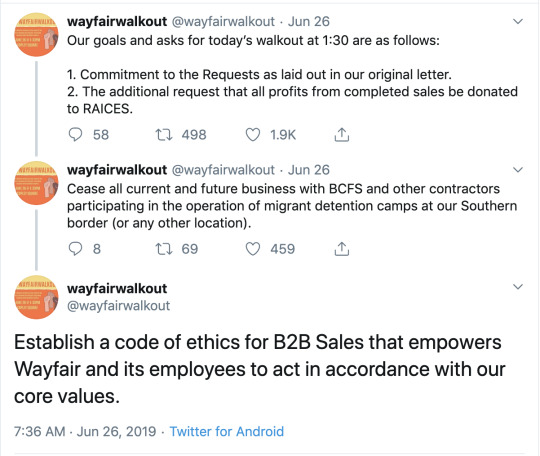
It is worth noting that these were not disgruntled employees. Organizers were quoted as saying, “We love Wayfair & working there. We don’t want to smear the CEOs. We just want to be able to feel proud of the work we do there.” (Matsakis, 2019). After the walkout, Wayfair still continued with the sale. Steve Conine and Niraj Shah, co-founders of Wayfair, announced a donation of $100,000 to the American Red Cross, not RAICES, in another letter to employees (Klar, 2019).
Reaction to the Wayfair Walkout
The “Page Principles” of telling the truth, proving it with action, and conducting public relations as if the whole enterprise depends on it could have all helped Wayfair navigate this situation (The Page Principles, n.d.). Let’s start with telling the truth.
youtube
Tell the Truth: On social media, the walkout gained attention. Unfortunately, Wayfair did not acknowledge the walkout or B2B sale on any of their social media channels. However, users expressed their displeasure with the sale in the comments section of the company’s Facebook, Instagram and Twitter pages. Protest organizers created a Twitter account the day before the walkout with the handle @wayfairwalkout. It had 22,000 followers by the day of the protest (Bhattarai, 2019). Elected officials, such as Rep. Alexandria Ocasio-Cortez (D-N.Y.) and Sen. Elizabeth Warren (D-Mass.), added their voices to the discussion as well.
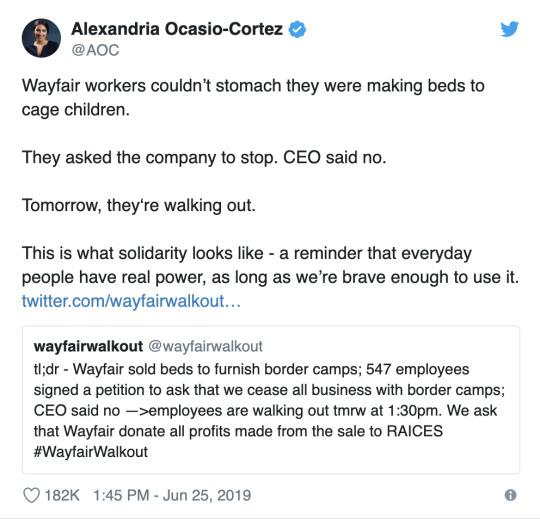

The employees that took part in this protest may have only represented 10 percent of the Wayfair workforce, but they were able to bring national attention to the ethical dilemma corporations may face when doing business with government contractors, especially as it relates to and reflects their stated company values.
youtube
In this case, Wayfair missed an opportunity to share why this sale reflected its values to its employees as well as to the public via their social media channels. In its mission statement, the company states that they “partner with organizations that play a meaningful role in creating safe and comfortable living spaces” and that they want to "make home a reality for more of the many people in need of safe shelter and basic household items that help make a home" (Social Responsibility, 2019). The connection could have been made that they are fulfilling this sale because they believe in creating as comfortable a living space as possible for detained migrants due to their belief in it being a basic human need and a foundation for a person’s well-being.
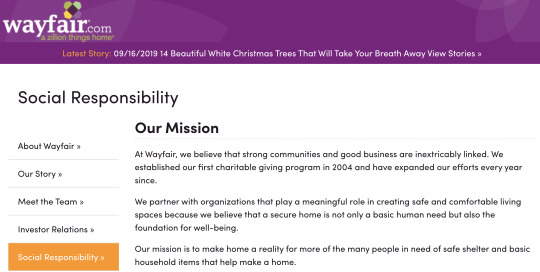
Prove It with Action: Words can only take a company so far. Instead of articulating the connection between the sale to BCFS with their values, Niraj Shah, Wayfair’s CEO, took a defensive stance and stated "it is standard practice to fulfill orders for all customers” and that they “sell to any customer who is acting within the laws of the countries within which we operate." They also intentionally ignored the request of their employees to donate to RAICES and instead donated to the Red Cross, which was half of what they earned from their BCFS sale. Both the words and actions of Wayfair showed a total disregard for their employees’ requests and desired outcomes.
Conduct Public Relations as if the Whole Enterprise Depends on It: They did not consider how the optics of their B2B sales with migrant detention center government contractors may seem to consumers and employees. Due to this, Wayfair opened itself up to criticism. Dedicating attention to consumer and societal trends could have helped avoid this situation to begin with. A 2018 Edelmen Earned Brand Study showed “that nearly two-thirds (64 percent) of consumers around the world now buy on belief” (Earned Brand 2018, 2019). This is up from 2017.
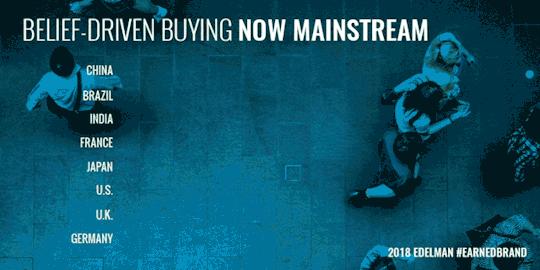
As a company based in the U.S., they would have benefited from educating themselves on the fact that a majority of Americans (62 percent) disapprove of the way migrants are treated at the border (Agiesta, 2019). This potentially translates into nearly 6 out of 10 people in their workforce having strong opinions on anything related to migrant treatment at the border. As of now, the financial effect this may have on Wayfair’s bottomline is yet to be determined. Brand loyalty may be a factor in the company's reported 40 percent more sales compared to last year. However, the company also reported a larger loss compared to last year. A year ago, they had a $100.7 million loss compared to $181.9 million this year (Thomas, 2019). With all the public attention on the company after the walkout, there may be a sense of urgency to invest more money into public-facing communications such as customer service and advertising. Time will tell if this strategy proves effective.
Sources
Agiesta, Jennifer. (2019, 2 July). CNN Poll: Three-quarters of Americans say there's a crisis at the border. CNN. Retrieved from https://www.cnn.com/2019/07/02/politics/cnn-poll-immigration-border-crisis/index.html
Bhattarai, Abha. (2019, 26 June). ‘A cage is not a home’: Hundreds of Wayfair employees walk out to protest sales to migrant detention center. The Washington Post. Retrieved from https://www.washingtonpost.com/business/2019/06/26/cage-is-not-home-hundreds-wayfair-employees-walk-out-protest-sales-migrant-detention-center
Earned Brand 2018. (2018, 2 October). Edelman. Retrieved from https://www.edelman.com/earned-brand
Klar, Rebecca. (2019, 26 June). Wayfair to donate $100,000 to Red Cross after employee protest over furnishing border facilities. The Hill. Retrieved from https://thehill.com/latino/450493-wayfair-to-donate-100000-to-red-cross-after-employee-protest-over-furnishing-border
Mabud, Rakeen. (2019, 12 July). Two Lessons From The Wayfair Walkout. Forbes. Retrieved from https://www.forbes.com/sites/rakeenmabud/2019/07/12/two-lessons-from-the-wayfair-walkout/#28c925cf3a88
Matsakis, Louise. (2019, 26 June). Wayfair Employees Are Walking Out. Here's Why. Wired. Retrieved from https://www.wired.com/story/wayfair-walking-out-border-detention
Social Responsibility. (n.d.). Wayfair. Retrieved from https://www.wayfair.com/v/about/social_responsibility
The Page Principles. (n.d.). Arthur W. Page Society. Retrieved from https://page.org/site/the-page-principles
Thomas, Lauren. (2019, 1 August). Wayfair shares whipsaw as costs build up and loss widens. CNBC. Retrieved from https://www.cnbc.com/2019/08/01/wayfair-reports-fiscal-q2-2019-earnings.html
Wischhover, Cheryl. (2019, 28 August). Wayfair, the internet’s massive online furniture store, explained. Vox. Retrieved from https://www.vox.com/2019/8/28/20833645/wayfair-many-brands-websites
#PRAD564#Wayfair#WayfairWalkout#WayfairMissteps#MigrantDetentionCenters#PublicRelations#ArthurPageSociety#PagePrinciples#Protest
0 notes
Text
White Claw Summer Leads to White Claw Shortage
By Joe Lanzerotti
Summary of Story
White Claw is an alcoholic beverage that was introduced into the market in 2016. It is owned by Mark Anthony Brands, the same company that produces Mike’s Hard Lemonade. White Claw is a hard seltzer, which is different than a spiked seltzer. A hard seltzer is brewed from fermented gluten-free grains, which produce a clear, flavorless alcohol that is then flavored and sweetened with cane sugar (Bryson, 2019). This is important because beverages that are brewed instead of spiked are taxed at a cheaper rate by the federal government, and can be sold in stores for a lower price. White Claw is affordably priced, has low sugar content, contains approximately 100 calories per drink, and includes 5% alcohol content by volume. The alcohol content is comparable to many light beers, while the calorie count and sugar content tend to be lower (Valinsky, 2019).

White Claw sales have experienced triple digit growth annually since the product was introduced to the market in 2016. In the past year alone, Nielsen and the New York Times report that “dollar sales [are] up 250 percent” (Bromwich, 2019). However, this massive growth has led to shortages across the country. In order to make sure that White Claw would be available in all markets, the company imposed an allocation limit for liquor stores and bars everywhere (Garrand, 2019). This means that no matter what the stores ask for when they order, they are allotted a certain amount that they can get. If a liquor store requests 100 cases of White Claw because they know that they can sell that in a week, they might only receive 40 cases due to the allotment. In this instance, this helps White Claw keep its product distributed across the country equally, but hurts the individual store that is now missing out on the sales of 60 more cases per week.
Forbes contributors David Sturt and Todd Nordstrom summed up the White Claw shortage well when they said that it “seem[s] like a perfect publicity stunt until you consider just how much more product [White Claw] could have sold if they could predict such an overwhelming response and social media frenzy” (Sturt, Nordstrom 2019). In response to the shortage, a White Claw spokesperson said that ���we are working around the clock to increase supply given the rapid growth in consumer demand” (Peterson, 2019). White Claw has mainly used Twitter to respond to their customer complaints as well. They have been using a mix of canned tweets that direct consumers to the ‘Contact Us’ section of their website, and personal replies to problems.

Reaction to Story
I believe that White Claw found itself in an interesting growth situation largely because of “meme culture”, and isn’t entirely to blame for the shortage of its products. Maintaining triple digit growth and 60% market share in a business that is booming almost overnight is a difficult challenge to face (Bromwich, 2019). White Claw has dedicated very little of its earnings and budget to marketing, and has chosen to let the masses tell their story for them. This has led to the borderline ‘viral sensation’ nature of its success, but it has also left a lot to be desired when it comes to owning up to their shortcomings. Real small businesses are losing money because White Claw can’t keep up with the demand, and not enough has been done from a communication standpoint to help alleviate those pains in the industry.

Listen To Stakeholders
The Arthur Page Principle Listen To Stakeholders is not being met at this time (The Page Principles, n.d.). Responding to a handful of customer complaint tweets a day with canned responses is killing any potential conversation that could be happening between the company and its stakeholders. The same can be said about the liquor store owners- more transparency is needed to help them manage the public’s expectations about when White Claw will be back in stock, and how much will be delivered per shipment.
Manage For Tomorrow
Another relevant Arthur Page Principle in this situation is to Manage For Tomorrow (The Page Principles, n.d.). White Claw rose to power largely because of meme culture and the younger demographic supporting it with Instagram pictures, Twitter jokes, and Snapchat stories. This narrative can quickly turn sour if White Claw fails to keep up with the demand. The popular hashtags #WhiteClawSummer and #WhiteClawWednesday have slowly been replaced with #WhiteClawShortage. If this trend keeps up, White Claw could become a 2019 fad, soon to be replaced by another trendy drink that can match the growing consumer demand for beer and wine alternatives.

Conduct Public Relations As If The Whole Enterprise Depends On It
The final Arthur Page Principle I would like to examine for this case study is Conduct Public Relations As If The Whole Enterprise Depends On It (The Page Principles, n.d.). White Claw has not been adhering to this principle, but it makes sense as to why they might be hesitant to launch a public relations campaign at this point in time. They grew exponentially without the help of a massive marketing budget. They purposely like to remain open to all audience segments and all kinds of people. If they were to launch anything too flashy at this time, it could backfire and turn their consumer base away from them. White Claw has allowed its younger fans to assign value to their brand through memes and internet jokes. Instead of fighting the tide of public opinion, it might actually be best in this scenario to lay low until a solution is really ready. When that time comes, it will be interesting to see how White Claw approaches their communication strategy. In the meantime, it is important for White Claw to ramp up its efforts in using Twitter to communicate with disgruntled customers and business owners alike who are being affected by the White Claw shortage.
Sources
Bromwich, Jonah Engel. (2019, 5 September). The memes are pouring the White Claw down your throat!. The New York Times. Retrieved from https://www.nytimes.com/2019/09/05/style/white-claw-popular-memes.html
Bryson, Lew. (2019, 10 September). How the hell is White Claw hard seltzer outselling Budweiser?. The Daily Beast. Retrieved from https://www.thedailybeast.com/how-the-hell-is-white-claw-hard-seltzer-outselling-budweiser?ref=scroll
Garrand, Danielle. (2019, 7 September). There is a nationwide shortage of White Claw hard seltzer. CBS News. Retrieved from https://www.cbsnews.com/news/white-claw-shortage-there-is-a-nationwide-shortage-of-white-claw-hard-seltzer/
Nordstrom, Todd & Sturt, David. (2019, 19 September). How the White Claw shortage in the U.S. could expose an international leadership crisis. Forbes. Retrieved from https://www.forbes.com/sites/davidsturt/2019/09/19/how-the-white-claw-shortage-in-the-us-could-expose-an-international-leadership-crisis/#500223866935
The Page Principles. (n.d.). Retrieved from https://page.org/site/the-page-principles
Peterson, Haley. (2019, 6 September). White Claw says it’s ‘working around the clock’ to increase production of the wildly popular hard seltzer amid complaints of shortages across the US. Business Insider. Retrieved from https://www.businessinsider.com/white-claw-shortages-increase-supply-2019-9
Valinsky, Jordan. (2019, 6 September). America is running out of White Claw hard selrzer. CNN Business. Retrieved from https://www.cnn.com/2019/09/06/business/white-claw-shortage-trnd/index.html
0 notes
Text
Glossier: A Case Study in ‘Managing For Tomorrow’ & ‘Listening to Stakeholders’
Antoinette Iacullo

SUMMARY OF THE BRAND
New York-based ecommerce beauty startup, Glossier, launched online in 2014 with just four products. It has since expanded to a full line of skincare, makeup, body & fragrance products. It closed a Series C round of funding earlier this year, raising $52 million, bringing total funding to $86 million (Mandell, 2018). Rumors of an initial public offering began to simmer after the last funding round (Basin & Wolf, 2018).

Communication to Stakeholders (February 22, 2018)
Glossier’s valuation reached $390 Million this year (Olsen 2018).Traffic is heavy, both literally and digitally— Its flagship NYC store does more sales per square foot than the average Apple Store (Gingras 2018) and there are more than two million unique visitors a month to the brand’s beauty blog, Into the Gloss (Bhuiyan 2018).
Dear Tech People reports 79% of Glossier’s staff is female, including its CEO, Emily Weiss. Weiss, 33yrs old, went from Teen Vogue Intern to beauty blogger to the ‘Estee Lauder for millennials’ in roughly three years (Mandell 2018). You may remember Weiss from her cameo as Super Intern on the MTV series ‘The Hills.’

Above: Then, 2007.
Below: Now, 2018.

Photograph by Ben Hassett
youtube
Emily Weiss (Glossier) & Kirsten Green (Forerunner Ventures) | Disrupt SF
Another titan of retail, Katrina Lake, Founder and CEO of Stitch Fix, the youngest female founder to take a company public, joined Glossier’s board of directors in June. Lake is the first independent director to join the board, which includes Weiss, Glossier president Henry Davis and three venture capitalists (Del Rey, 2018).

Glossier is simultaneously innovating and disrupting ecommerce, with its tech-forward, direct-to-customer product and communication business model. It has a strong brand identity, synonymous with ‘Millennial pink’ and minimalist aesthetic, with a mission to serve as a conduit for connection. Glossier’s value is not in the sheer scale of its user base, rather, the social activity happening on its user network (Andjelic, 2018). And I would argue, much of Glossier’s value is its People Capital.
MY MUSINGS & REACTION
In a study of the 4-year old startup, via the lens of The Page Principles, ‘Manage For Tomorrow’ and ‘Listen to Stakeholders’ are seemingly embedded in Glossier’s core tenets. Meanwhile, ‘Conduct public relations as if the whole enterprise depends on it’ is a work in progress for this rapidly evolving Brand. And one I believe will only become more challenging, given Glossier does not appear to have a Chief Communications Officer; Instead, Weiss serves as the foremost voice and image of the Brand.
Manage For Tomorrow
Weiss believes “we’re really at the dawn of ecommerce,” which makes up just about 10% of global commerce (Olsen, 2018). “My job is to be thinking 12 months to two years ahead,” she writes in an ITG blog post (https://intothegloss.com/2016/01/meet-emily-weiss/).
Glossier quietly acquired Montreal Digital agency, Dynamo, at the close of 2017. Dynamo helped Glossier with its U.S. launch, developing its website and ecommerce platform. Following the acquisition, Dynamo Co-Founder Bryan Mahoney was named CTO at Glossier (Kolm, 2018).
With the additional venture capital funding injected in February, Glossier is preparing to enter “Phase Two,” creating a social-commerce site. Though Glossier’s Instagram account has roughly 1.5 million followers, Weiss wants to build her own version of a social media and shopping mashup and she hired Keith Peiris, a developer who led teams at Instagram, Facebook Inc., and Oculus, as Glossier’s product chief to spearhead the new site (Perez, 2018).
Listen to Stakeholders
Glossier launches a new product every six weeks, on average, and spends a lot of time working on its formulas and engaging in two-way conversation between product teams and its user community. For example, crowd-sourcing input to co-create its cornerstone product, Milky Jelly Cleanser and inviting 100 of Glossier’s top customers to participate in a Slack channel, exchanging thousands of messages weekly. “That’s the difference between a marketing tactic and actually having your customer engaged in your process and your brand,” says Weiss (Chapin, 2016).


How to not conduct PR as if the whole enterprise depends on it
Glossier has been criticized for not being particularly concerned with explaining the science behind its products, “Weiss just doesn’t think her customers care about ingredients if they’re happy with the results,” according to a spokesperson for Glossier (Larocca, 2018). But Glossier claims that its lack of transparency is a matter of safeguarding business assets.

Glossier received backlash in response to its Instastory thread, which promoted the benefits of Glossier’s Solution, a chemical exfoliating toner, while slamming competing products from industry-revered brands, like Biologique. Many felt Glossier was ill-positioned to opine on other acid formulas when the percentages of its proprietary acid blend are not disclosed. Further, Glossier’s authoritative voice on chemical products felt ingenuine, when fragrance, a known skin irritant, is a listed ingredient in Glossier’s Solution. Further hypocritical, Glossier threw shade at the same competitors that it previously lauded on Into the Gloss.
Luckily, Glossier’s brand image of inclusivity and transparency seems largely intact since its very off-brand misstep, but as Warren Buffet has cautioned, it takes significantly less time to ruin your reputation than it takes to build it.
SOURCES
Andjelic, A. (2018, October 19). Opinion: The ‘4 Cs’ of the modern beauty brand. Glossy. Retrieved from http://db.glossy.co/platform-effect/opinion-the-4-cs-of-the-modern-beauty-brand
Bhasin, K. & Wolf J. (2018, August 30). Inside Glossier’s plans to shake up your makeup routine. Bloomberg. Retrieved from https://www.bloomberg.com/news/features/2018-08-30/millennial-makeup-brand-glossier-shakeup-makeup-routine
Bhuiyan, J. (2018, September 18). Emily Weiss wants Glossier to own the online beauty conversation. Recode. Retrieved from https://www.recode.net/2018/9/18/17869814/glossier-emily-weiss-makeup-beauty-engagement
Chapin, A. (2016, January 11). Emily Weiss explains why people are freaking out about Glossier. Racked. Retrieved from https://www.racked.com/2016/1/11/10749536/glossier-emily-weiss-into-the-gloss-new-cleanser
Del Rey, J. (2018, June 26). Stitch Fix CEO Katrina Lake has joined the board of Glossier. Recode. Retrieved from https://www.recode.net/2018/6/26/17501370/katrina-lake-glossier-board-director-stitch-fix
Gingras, M. (2018, April 18). While retail’s behemoths die, these 4 retailers are rising from their ashes. Entrepreneur. Retrieved from https://www.entrepreneur.com/article/312112
Kolm, J. (2018, March 2). Glossier acquired Dynamo. Strategy. Retrieved from http://strategyonline.ca/2018/03/02/glossier-acquires-dynamo/
Larocca, A. (2018, January 8). The magic skin of Glossier’s Emily Weiss. New York Magazine. Retrieved from https://www.thecut.com/2018/01/glossier-emily-weiss.html
Mandell, J. (2018, February 22). Glossier just got $52 million in fresh capital, bringing total funding to $86 million. Forbes. Retrieved from https://www.forbes.com/sites/jannamandell/2018/02/22/glossier-just-got-52-million-in-fresh-capital-bringing-total-funding-to-86-million/#1a1dd56412b6
Olsen, D. (2018, September 2018). The changing face of beauty brands in an Instagram-obsessed world. PitchBook. Retrieved from https://pitchbook.com/news/articles/the-changing-face-of-beauty-brands-in-an-instagram-obsessed-world
Perez, S. (2018). Glossier CEO Emily Weiss on why the company won’t sell to Amazon. Tech Crunch. Retrieved from https://techcrunch.com/2018/09/07/glossier-ceo-emily-weiss-on-why-the-company-wont-sell-on-amazon/
0 notes
Text
Facing turbulence at ground level, Delta scrambles to resolve its computer crash crisis

Summary
On August 8, 2016, Delta experienced a crash of its computer systems which led to the cancellation of thousands of flights worldwide. For an airline known as the second largest in the world, it was a problem of epic proportions. The ensuing crisis lasted for 3 days, affected many passengers across the globe and resulted in the cancellation of more than 1,000 flights on the first day and around 1,000 more flights on subsequent days (DiPietro, 2016). The crisis caused confusion, delays and financial losses for Delta and its customers. Within hours of the onset of the crisis, customers reacted by unleashing about 43,000 tweets on Twitter instead of the usual 3,600 social conversations (Carey, 2016).
Delta initially explained that the problem was due to a power outage. Georgia Power promptly denied the charge, stating that the problem was due to Delta’s failed switchgear (Scott & Nomiyama, 2016). Delta later stated that the problem arose from a power surge to its transformer and the failure of its critical systems to switch to backup. It apologized and offered travel waivers to customers who want to reschedule their flights. It also offered $200 travel vouchers as compensation to those affected (News.delta.com, 2016). Below is a brief timeline of how the crisis unfolded and Delta’s response.
Monday, August 8, 2015
2:30 AM – Delta suffers loss of power. Computer systems crash occurs, affecting operations.

5:11 AM – Delta acknowledges power outage and puts in place a ground stop. It later lifted the ground stop and said limited departures are resuming.
6:39 AM – Using its Twitter feed, Delta tells customers headed to the airport to expect delays. It informs them that there might be a lag time in display of accurate flight status on its website and app.
11:08 AM – Georgia Power denies responsibility for the outage. Its spokesman John Kraft said, “It was a failure of Delta equipment, adding, there wasn't an area power outage and the Delta problem did not affect other power customers” (Scott & Nomiyama, 2016, para. 2).

11:48 AM – In a video apology, Delta CEO, Ed Bastian, gives an update and addresses distressed customers while speaking from the operations and customer center in Atlanta.
5:26 PM – Delta announces the offer of $200 travel vouchers to compensate to all customers who have experienced a 3+ hour delay or cancellation.

Tuesday, August 9, 2016
5:37 AM – Delta announces the cancellation of more flights. It also announced continued travel waivers and asked customers to check their flight status online.
12:25 PM – In a press release posted on its news hub, Delta’s COO, Gil West gives an update on the situation. He said the cause of the systems crash was a power surge to a transformer and the inability of its critical systems to switch to backup. He explained that this was causing slowness in the system for check-ins, boarding and dispatching of aircraft. It is also affecting pilot and flight attendant rotations.
5:08 PM – In a new video statement, Delta CEO, Ed Bastian gives another apology saying, “This is not who we are.” He assured customers that the system is now running slowly and the company will do everything to avoid a similar situation in the future.
Wednesday, August 10, 2016
6:48 AM – Delta gives more updates to customers and asks them to check their flight status online. It extends its offer for travel waivers and compensation until August 11.
9:27 AM – Delta says 80% of departures are leaving within 30 minutes of departure time.
12:57 PM – Delta says its operations are now back to normal.

Reaction:
I think Delta acted quickly and responsibly in its response to the crisis. With all its systems down, it began communicating with its customers and the media using its dedicated news hub and social media channels like Twitter and Facebook. Within hours, the CEO gave an apology. This appeared effective as it cleared the initial speculation that the company was hit by hackers. The company engaged with its customers by offering travel waivers and compensation to those affected. I believe the CEO’s video apology followed by a press release by the COO helped to calm some nerves. In essence, Delta quickly owned the problem, worked on solutions while considering its affected stakeholders. I think the company had a crisis plan in place and kept up timely communication efforts all the way through the crisis. It is instructive to note that Delta’s share value during the crisis only dropped slightly from $37 on August 8 to $36 on August 12. It now stands at $39 per share (Yahoo Finance, 2016).
On the other hand, Delta seemed to downplay the problem in the early stages without being sure that a solution was in place. It could have avoided the situation that led to its unnecessary confrontation with Georgia Power. In addition, it delayed the offer of compensation to customers for a while. This could have had more impact if it was announced during the CEO’s first apology video. Finally, the CEO was not specific about what steps the company would take to reduce the vulnerability of its computer systems. His promise was simply that everything would be done to ensure that such a situation does not arise in future.
Page Principles:
Tell the truth.
After its initial effort to downplay the situation and shift blame, Delta was generally truthful in the way it handled the crisis. It owned the problem and communicated with passengers. It sent out advisories on what to expect and what passengers could do while reassuring them that the company was working on a solution to the problem.
Prove it with action.
Delta did not only communicate, it acted with sincerity to find real solutions to the problem. The CEO apologized twice and demonstrated sincere regret by offering travel waivers and compensation to those affected by the delays and cancellations. The company considered the outcome of the computer crash on its customers and took concrete actions that could alleviate it.
Listen to the customer.
The major focus of the airline during the crisis were its stakeholders, especially its customers. Using its social media channels, it tried to communicate with them and addresses their concerns. It referred them to agents to rebook their flights, put some in hotels, offered drinks and pizza and sought out ways it could make things easier for them. It worked hard to rectify the problem and ameliorate the concerns of its stakeholders.
Manage for tomorrow.
Delta and its management certainly know that the future of its business depends a lot on sustaining the loyalty of its passengers and other stakeholders. Delta pulled out all the stops and offered compensation to its customers for the inconveniences they suffered. Though there might be big short term financial losses due to this decision, it shows clearly that Delta had its eyes on the future and is focused on keeping the loyalty of its customers in the long term.
– – –
References
Carey, S. (August 8, 2016). Delta meltdown reflect problems with aging technology. The Wall Street Journal. Retrieved from http://www.wsj.com/articles/delta-air-lines-says-computers-down-everywhere-1470647527
Dipietro, B. (August 22, 2016). Crisis of the week: Delta grounded after computer crash. The Wall Street Journal. Retrieved from http://blogs.wsj.com/riskandcompliance/2016/08/22/crisis-of-the-week-delta-grounded-after-computer-crash/
Facebook.com. (August 8, 2016). A message from Delta CEO Ed Bastian: ‘This isn’t who we are’. Facebook. Retrieved from https://www.facebook.com/delta/videos/1268434493175730
Isidore, C., Mullen, J. & Sutton, J. (August 8, 2016). Travel nightmare for fliers after power outage grounds Delta. CNN Money. Retrieved from http://money.cnn.com/2016/08/08/news/companies/delta-system-outage-flights/
News.delta.com. (August 9, 2016). Chief operations officer gives Delta operations update. Delta News Hub. Retrieved from http://news.delta.com/chief-operating-officer-gives-delta-operations-update
News.delta.com. (August 9, 2016). Delta CEO Bastian: This isn’t who we are. Delta News Hub. Retrieved from http://news.delta.com/delta-ceo-bastian-isn-t-who-we-are
News.delta.com. (August 10, 2016). Compensation offered for customers affected by cancel, delays. Delta News Hub. Retrieved from http://news.delta.com/compensation-offered-customers-affected-cancels-delays
Scott, A. & Nomiyama, C. (August 8, 2016). Georgia Power says Delta Airlines equipment failure led to outage. Reuters. Retrieved from http://www.reuters.com/article/delta-air-outages-georgiapower-idUSL1N1AP0QT
Twitter.com. (August 8, 2016). CEO Ed Bastian apologizes to customers for the disruption to the airline's operations today. Twitter. Retrieved from https://twitter.com/deltanewshub/status/762707203207761920
Yahoo.finance.com. (October 7, 2016). Delta Air Lines Inc. Yahoo Finance. Retrieved from http://finance.yahoo.com/quote/DAL?p=DAL
0 notes